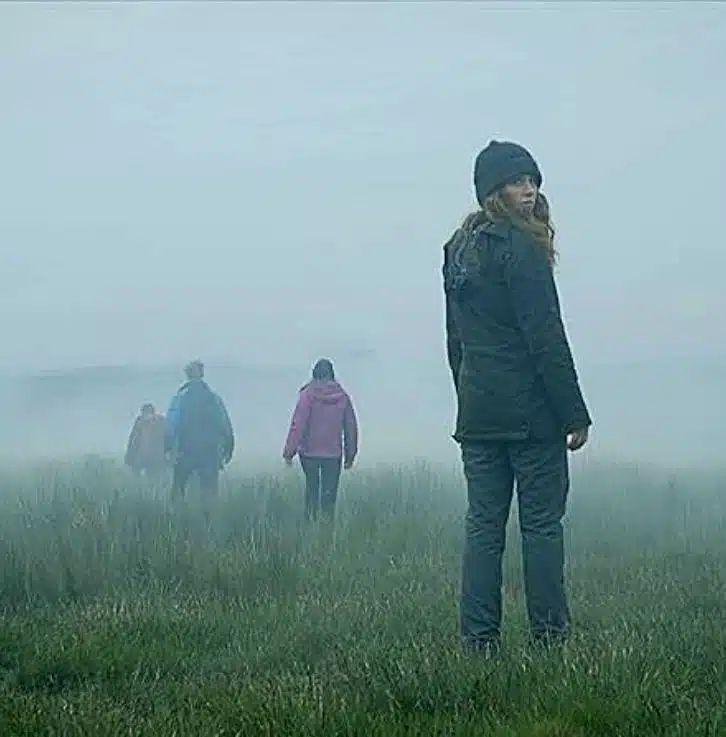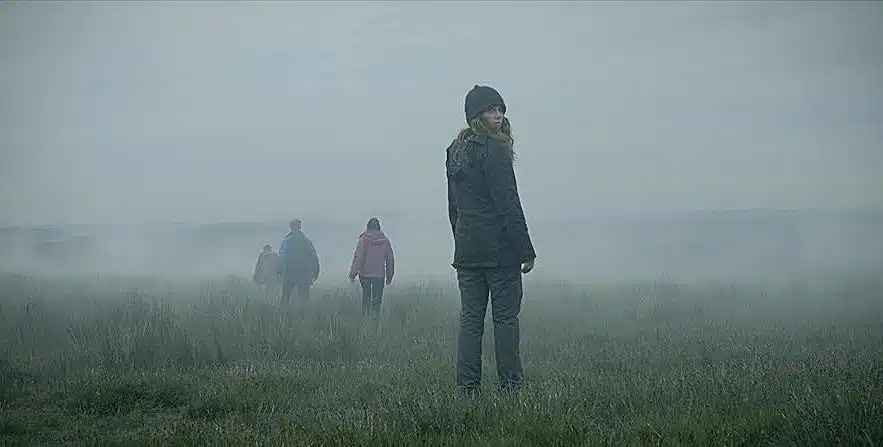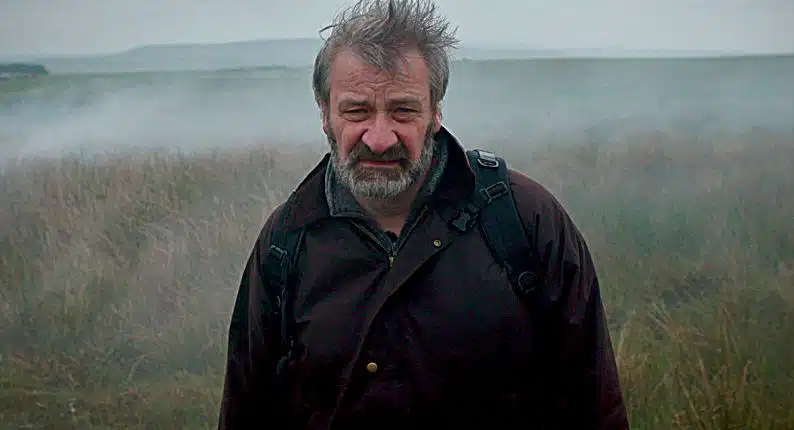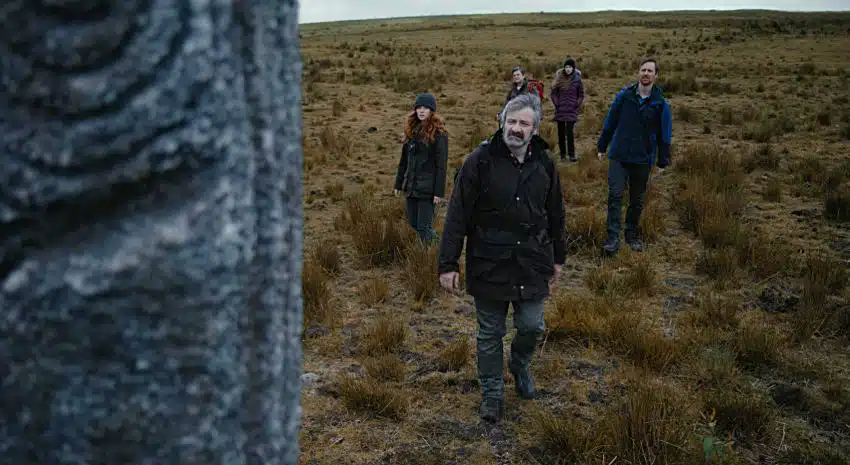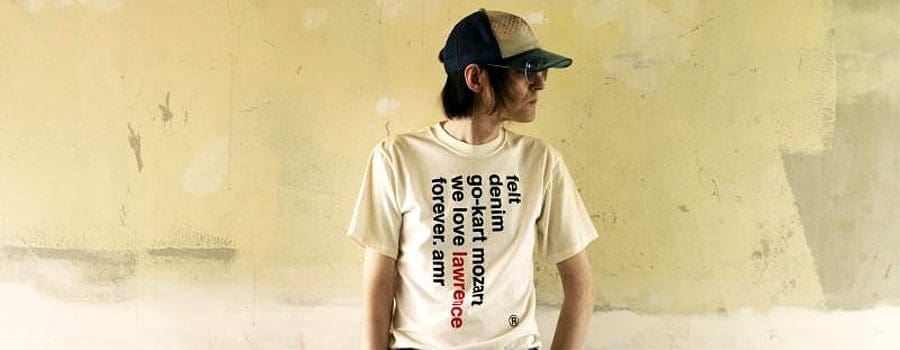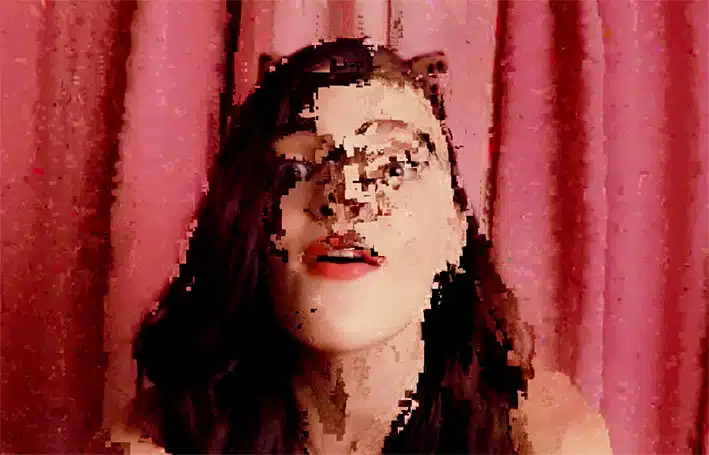words Christina Brennan
It’s a familiar horror fan cliche to say that the found footage horror is a defunct type of horror movie. Critics often opine that no originality can be squeezed out of new additions to this genre. Yet director Chris Cronin, in his debut feature film The Moor, which premiered at last year’s FrightFest, one of the UK’s top horror film festivals, has proved that found footage can rise from the dead. Together with The Moor’s writer, Paul Thomas, Cronin has put together a slow-burn horror that begins as a Northern crime film, depicting a 1990s-era child abduction that echoes the notorious Moor Murders. Two school kids, Claire (Billie Suggett) and Danny (Dexter Sol Ansell), head to their local corner shop. Only Claire returns home. From a claustrophobic opening sequence in the corner shop, the film quickly evolves into an eerie folk horror set on the Yorkshire Moors. Flashing forward twenty-five years, Claire (Sophia La Porta) is approached by the father of one of the victims, her childhood friend, Danny, and asked to help investigate where Danny’s remains may be on the vast, haunting expanse of the Yorkshire Moors. What follows is a folk-horror with queasy hints of The Wicker Man (1973) and more recent folk horrors like A Field in England (2013) and Borderlands (2013).
Ahead of The Moor’s screening at the Manchester Film Festival in March 2024, Chris Cronin sat down with Christina Brennan to chat about The Moor’s backstory, production, and inspirations.
Can you start by telling me about the backstory of this film, including how the screenplay was developed and how you built the production team?
The Moor is a collaboration between me and another talented Yorkshire-based film writer, Paul Thomas. We were working together on another horror project, but we had to pause this project when COVID-19 lockdowns hit and the UK film industry shut down. We then looked at the entire script for The Moor, and I was drawn to it because it featured elements of found-footage horror. I’ve always loved this concept as a horror fan and filmmaker. Fans and critics often say that found-footage horror is a low-budget genre, but I find it very challenging as a filmmaker – in a good way! It’s a sub-genre with its own rules that can be more challenging than the traditional shooting style. The script made me uncomfortable in all the right ways – especially the twist ending. As a director, if something in the script catches your attention, then that’s a good sign that the film will be challenging and productive and maybe even push you in new directions as a filmmaker.
The Moor engages with a dark history of Yorkshire. There’s echoes of the Moors Murders, especially in the early sequences, and I felt there was a crime/noir element to the film. Do you recognise this in The Moor?
We certainly wanted to do a mature horror – not a ‘blood and guts’ type of movie. But we connected on our childhoods, both from Huddersfield, and we both remember feeling something off about the moorland in that area. Our parents never told us about it, but they acted strangely about it. We remember being kids and not wanting to go up there but not being sure why. But we tried to tap into that childhood fear. Through the writing process, we dug into over a 1,000 years of moorland history and events and myths, such as the excavation of the Lindow Man preserved in the peat in British moorland. Other myths are the standing stones. So it turned into a folk horror. While the crime elements are eye-catching, we wanted the folk horror elements to emerge more fully throughout the film.
So, do you see The Moor as a horror hybrid film that intersects with other genres, including the crime-thriller film?
I have a natural inclination towards crime thrillers, but I knew The Moor would be a character-focused horror and that there would be a gradual descent into more obvious, icy horror throughout the film. We wanted it to open with a realistic moment of horror in everyday life – the disappearance or abduction of a child – but have it descend into a darker, ambiguous type of folk horror that might catch the audience off guard. I think the film is a hybrid film combining multiple genre conventions – I’ve had divided responses from audiences. Those who like crime have been engaged by those elements (and quite shocked by the ending!), and those hardcore horror elements have leaned into the elements that become prominent towards the film’s final half. I think there’s been a recent resurgence of true-crime thrillers on both TV and film, while horror has long-term popularity but tends to go in cycles. Hopefully, The Moor merges into two types of genres.
Can you talk about the symbolism of the moor in the film? Moorland is an iconic feature of the northern landscape – why did you make it so central to the horror in your film?
In places like the Yorkshire moors, you still see evidence of a deeper, unknown history in Britain – everything from Stonehenge, Standing Stones, and the Lindow man to other obscure sites that allude to a darker, unknown history from thousands of years ago. These things provoke the imagination, and there are landscapes in Britain, like the moorland across Yorkshire and Lancashire, that feel timeless, raw and scary. That landscape is easy to tap into, and it’s a source of fear and horror that I remain very curious about. There’s a sense of an ancient world in this area – an immovable force that can swallow you up and a force that you can’t reason with or control, however much you might try.
Moorland is a central and recurring symbol in the film; it’s almost a character. How did you want to convey The Moor’s raw landscape? Why was that the focal element?
There are a lot of things that creep up in different ways. It was a process of trying to present the unknown without giving away too many answers or spoiling the ending. There are clues throughout the film and the iconography of the landscape – if you watch The Moor a few times, you will see patterns and the same clues popping up repeatedly. I find it unsatisfying when horror films wrap up too neatly – I prefer to be given an ending that allows me to decide what happens for myself, and I hope that The Moor provides this for its audience.
Please talk more about your horror inspirations. It’s a genre with many faces and many sub-genres. Which films inspired The Moor?
1970s horror was an inspiration for the film. A key inspiration would be The Wicker Man (1974), which has folk elements and a twist ending. Like many horror films, I am a fan of The Exorcist (1973). We’ve also been influenced by Don’t Look Now (1974). If you know that film, you may see some correlations between the ending of Don’t Look Now and The Moor. We wanted that twist horror ending, and films that inspired us had endings that really stuck in the audience’s mind and haunted them after the closing credits. The greatest fear most people have is the fear of the unknown, and you want to explore that feeling in horror films. I have a filmmaker friend who calls this feeling’ horror grief,’ which alludes to how films can sit with you and haunt you. I’ll be happy if I can extract some echo of that feeling from the film’s audience.
Can you share anything about your next projects? Will you stay in their horror genre space or have any other project in the works?
I’m thinking of another Northern-set film featuring known names from the area. I want to tell larger stories in smaller places. This is similar to Stephen King’s use of Maine in New England, US, where he sets most of his novels in Maine. We’ve thought about a Gothic tale set in York – an old, medieval city with a darker history as one of the most haunted places in Europe, with clearly modern buildings and life. I’d love to shoot more in the North and illuminate its darker history.
The Moor will be screening at the Manchester Film Festival on 20 March 2024 and will be coming to UK cinemas in June 2024.

